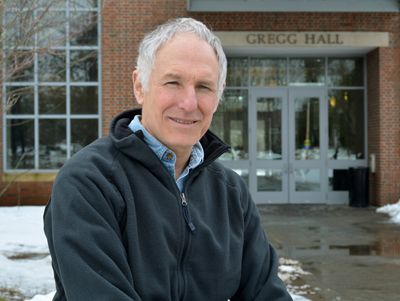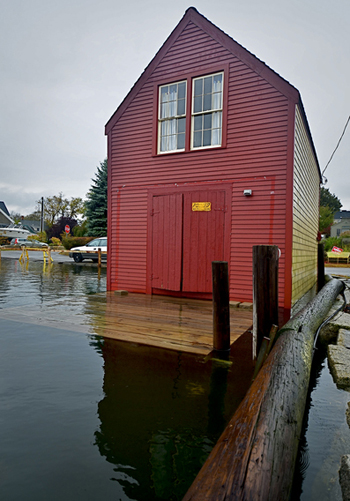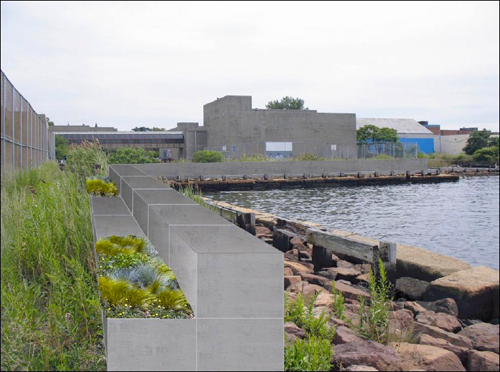Spring 2013
Climate Change Research at EOS
AMONG OTHER THINGS blown away by Hurricane Sandy in October 2012 was the notion that climate change was a thing of the future and that humanity had plenty of breathing room before having to gear up against its onslaught.
"Sandy really changed the landscape and caused a step increase in climate change adaptation thinking," says research professor Paul Kirshen.
At least that's what Kirshen, a civil engineer with joint appointments at EOS and the UNH department of civil engineering, is seeing in his line of work.
For example, Kirshen has ongoing climate change adaptation projects underway in the Boston area but after Sandy immediately saw evidence of that step change in interest and concern.
"Agencies that were just thinking about climate change and what do to at their facilities are now issuing requests for proposals. I can name two cases in the Boston area where managers of large infrastructure systems have decided they want to spend hundreds of thousands of dollars right now to plan what do to if another Sandy comes along," Kirshen says.
 | |
| Paul Kirshen Photo by Kristi Donahue, UNH-EOS. |
Closer to home, Kirshen works with Cameron Wake of the Earth Systems Research Center within EOS as part of the New Hampshire Coastal Adaptation Workgroup on several climate change adaptation projects, including one in Exeter, N.H.
The two researchers are also part of the UNH-led Infrastructure and Climate Network (ICNet) funded by the National Science Foundation in an effort to forge more common ground between the disparate worlds of engineers and climate scientists.
Notes Wake, "The ICNet project is about building a network among engineers and climate scientists who live in very different worlds. We think about things differently, use different languages, publish in different journals, and rarely work together. So it's not easy for climate scientists to go talk to engineers, and vice versa, but Paul is different because he has a foot in both fields."
Says Kirshen, "I'm a civil engineer trained in systems analysis but the field I work in is called 'adaptation.' And while I wouldn't call my research unique, it is groundbreaking because the whole field of adaptation is pretty new."
To wit, although Kirshen has been doing civil engineering adaptation work for a couple of decades, only in the last five years have people begun to realize society can, and must, practice adaptation engineering.
"The kind of engineering planning we have to do now is different from the past, which always built infrastructure for the long term under unchanging climate conditions," Kirshen says. "Today, we have to design with the explicit recognition that the climate is changing, and one approach requires an emphasis on flexibility and adaptive management."
If you build, it might come
Kirshen's particular approach to this flexible and adaptive civil engineering is to plan for the long term and implement measures only when climate change manifests itself, instead of over fortifying against an uncertain future.
This incremental, progressive method to infrastructure design and building is aimed at protecting people, buildings, and budgets at the same time.
"Because the changes are uncertain—for example, we can only say that between now and 2050 we'll see between a one- and two-foot rise in sea level—what you want to do is closely monitor the climate so that when it's clear it has changed to a certain critical value for certain types of infrastructures you know now it's time to take action," Kirshen says. "You don't build prematurely, you build when you need to."
That's easier said than done, of course, because due to natural variability and long-term decadal signals like El Niño and the North Atlantic Oscillation, an extreme event could signal either a climate change threshold or just an anomaly.
Says Kirshen, "So it's very difficult to detect when you're at a changed climate, and I'm working with colleagues on techniques to better ascertain when the climate has actually changed."
That work entails statistical trend analysis combined with decision theory and, Kirshen notes, "What we're including in the analysis are the implications of over- or under-building, which is why you really care about trend detection."
In other words, boiled down to the bottom line, it's infrastructure planning that tries to provide an accurate heads up for decision makers so that the biggest bang for the climate change buck can be achieved.
"You always hear about the astronomical cost of adaptation from people, but this work shows them that they needn't do anything until they have too. Of course," Kirshen cautions, "when you finally do rebuild infrastructure under current conditions, you need to make it climate change resilient."
The term "resilience" is now part and parcel of civil engineering climate change adaptation work. Kirshen notes that it came out of ecological literature of the 1970s but is now being applied to designing infrastructure systems so that they can "recover or bounce back" rather than crumble or wash away in the wake of insults hurled at them due to changing climate.
Fail-safe or safe-to-fail?
Making structures climate change resilient can actually recognize and include eventual "failure" into the design. That is, since engineering design standards have always been based on hard-and- fast numbers and structures are not supposed to fail, a new kind of thinking is indeed required to build things so they're not necessarily fail-safe but instead, in some instances, "safe-to-fail."
 |
|
| Today, infrastructure must be designed with "the explicit recognition that the climate is changing." Photo by Tim Hayes courtesy of Piscataqua Region Estuaries Partnership. |
"Today we realize that under the regime of a changing climate we simply can't protect everything, some things are going to fail and we have to be prepared to deal with that as part of the plan," says Kirshen.
For example, under the new planning paradigm, a community might build decades-long protection up to a certain level of flooding but then, knowing that level will eventually be exceeded, put in an evacuation strategy as part of the master plan. That said, the plan would also provide for flood-proofing the most vulnerable buildings prior to evacuation so that when the waters recede people can return and get on with their lives.
"I think that's the future, we don't necessarily have to invest in a massive seawall but, rather, design our communities over the next few decades so that they are floodable, we adopt a smaller, more decentralized approach," Kirshen says.
He adds that, up till now, there haven't been many opportunities to push this type of approach, but the times they are a-changin'.
"The hardest thing, and this is changing because of Hurricane Sandy, has been people saying climate change is too far away and too expensive to deal with. Those same people are now realizing they don't have the luxury of taking that stance and, slowly, they're starting to ask for help." Kirshen adds, "Now, with some solid information in hand, it's really a matter of the politicians, planners, and community members having the courage and confidence to act."
